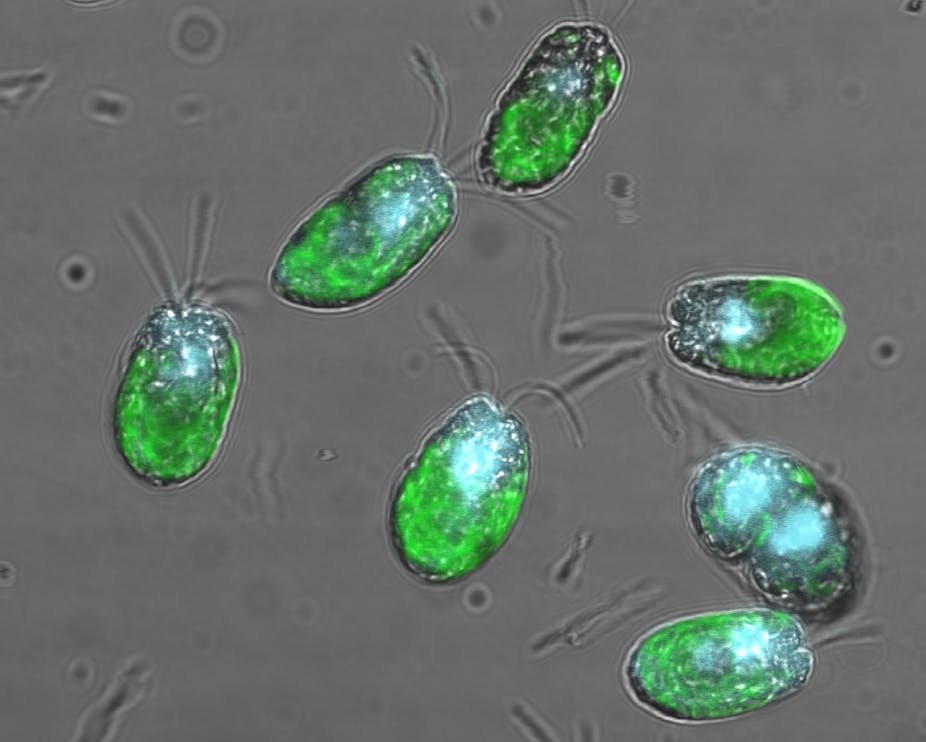Leave a glass with nutrient-rich pond water on a sunny window sill and within a day or two it will have turned a very vibrant, verdant green. This apparent alchemy has less to do with chemistry and more to do with biology: the green is microalgae - microscopic, free-floating, single cell, plant-like organisms. Given water rich in fertiliser (washed off from fields) or organic waste, sunlight and carbon dioxide these organisms grow rapidly, multiplying at an astounding rate by turning the nutrients and carbon dioxide into biomass. Importantly, algae don’t store energy as starch like most plants, but instead are full of vegetable oils - which makes them the equivalent of green gold.
Recent decades have witnessed several cycles of interest in being able to exploit these organisms. Research has examined the use of algae for remediating waste water or nutrient-overloaded coastal seas, absorbing carbon dioxide from the atmosphere or directly from industrial chimneys, in beneficial products such as proteins and antioxidants, and to produce oil and liquid fuels. Given its indisputable virtues, why has microalgae not been put to use in these ways?
Like many great ideas, the concept is simple but the execution is complex. You might expect to find algae farms springing up everywhere, judging by some reports in the media. But despite billions of dollars in investment from government, industry and venture capital funds, microalgae has still not been cultivated on a large scale. Some colleagues and I looked at some of the technological hurdles to microalgae biofuel production in a 2010 paper published in the Royal Society Interface Journal.
In order to convert the oils from microalgae into biodiesel (known as fatty acid methyl esters, or FAME), the first hurdle is to separate the algae from the water. Algae is present in water at around 0.1% of the mass, so, a tonne (1m3) of water can produce 1Kg of microalgae. Evidently that means 999Kg of water must be removed. To process enough algae to be worthwhile this has to be done rapidly, but unfortunately this is not a trivial operation. The algae are microscopic and about the same density as the water, which makes it hard to separate by conventional filtration or in a centrifuge. Flocculation with chemicals, a common method in water treatment works, uses highly charged polymers or metals to attract the algae together so they sink. It’s effective, but adds expense and complexity.
What’s more, microalgae are about 30-40% oil content by dry weight, and the 1Kg of weight above is wet. Dried, the 1Kg of microalgae might weigh 100g, so would yield perhaps 30-40g of oil. The oils may be extracted using solvents or pressing, and then converted to prepare biodiesel. However, the chemistry required to do this means not all the oil can be converted, further lowering the potential yield.

Genetic modification of algae could be used to improve various characteristics, such as ease of harvest, cell wall rupture, or oil yield. But the impact of a GM microalgae accidentally released into the wild needs careful consideration.
However, a major benefit of microalgae is that it can be cultivated on marginal coastal land that is not used for food crops, and can use seawater rather than fresh water. This alleviates the main ethical accusations levelled at biofuels, that they affect food production. Algae has even been demonstrated growing while integrated into the fabric of buildings, with building fascia panels used for growing microalgae cultivated on wastewaters and carbon dioxide emissions.
Processing still represents a challenge, but advances in microfiltration and physical flocculation methods have led to significant improvements. Other means of converting microalgae oils to biodiesel have been trialed. For example, hydrothermal liquefaction - where wet, whole microalgae biomass is heated under pressure - and pyrolysis - where whole microalgae are heated rapidly in an oxygen-free environment - are two methods that don’t need the oil to be extracted before converting to biodiesel.
The first stages of microalgae fuel development were characterised by intense hype. This has passed, and the challenges are now well understood. The path forward requires considerable improvements in economics for large-scale cultivation for biodiesel. As such, greater success may come from integrating microalgae cultivation into waste-water treatment and carbon dioxide emission reduction programmes, where the fuel is a beneficial side effect. Alternatively, a model that focuses on creating a high value product - health supplements, for example - with the biofuel oils as a secondary revenue stream.
So while large-scale cultivation is undoubtedly possible, methods to remove water at low cost remains a hard nut to crack. Matching algae with high cell densities and rapid growth rates with low cost water removal methods will be a big leap forward for microalgae biofuels. But as ever, technology is but part of the challenge - the societal, political and legislative framework will also need to be in place.

